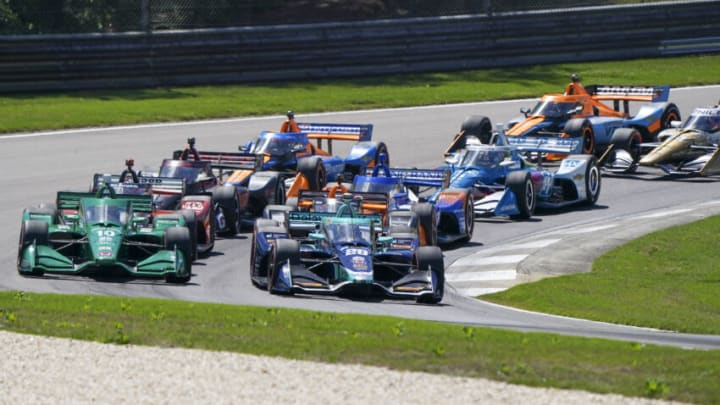IndyCar’s decision to throw the caution flag when they did on Sunday affected the outcome of the Children’s of Alabama Indy Grand Prix at Barber Motorsports Park.
Team Penske’s Scott McLaughlin fought back after being passed by Andretti Autosport’s Romain Grosjean, retaking the lead from the polesitter before going on to secure his fourth career IndyCar victory and first of the 2023 season. The victory vaulted him from a ninth place tie to fourth in the standings.
McLaughlin was the leader of the drivers on the three-stop strategy, while Grosjean, who started from the pole position, was the leader of the drivers on the two-stop strategy and led a majority of the laps (57 of 90) around the 17-turn, 2.38-mile (3.83-kilometer) natural terrain road course in Birmingham, Alabama.
On lap 38, the No. 51 Dale Coyne Racing with Rick Ware Racing Honda of rookie Sting Ray Robb came to a stop off the track in turn nine. The caution flag didn’t fly initially, but once all the drivers on the three-stop strategy came into the pits knowing that it eventually would, it did.
IndyCar’s decision drew plenty of criticism, and for obvious reasons.
Had the caution flag flown when the issue actually arose, the pits would have been closed, and everyone who needed to pit would have done so during the caution flag period once they opened again. But they would have restarted at the back of the pack.
Instead, they restarted throughout the field, with McLaughlin in second place behind Grosjean, a net gain of about 10 positions.
Still not a fan of the “selective timing” of a caution. The car is equally “dangerous” now as it was 2 minutes ago… if it affects a strategy so be it but Indycar should not be subjectively choosing when to throw a yellow.
— Champweb (@champwebdotnet) April 30, 2023
If it’s NOT dangerous then don’t throw a yellow.…
Marco Andretti also shared his thoughts.
Great effort/drive from @RGrosjean . 💪🏽 The yellow/Letting the 3 stoppers pit under green stacked it against him.
— Marco Andretti (@MarcoAndretti) April 30, 2023
That is quite literally what happened; IndyCar let certain drivers make pit stops. Certain drivers were aided by the decision.
At the end of the day, it’s race manipulation. It’s that simple. While the whole goal is not to interfere in the pit sequence, it does the exact opposite. It rewards those who got the strategy wrong. Some may pin it down to removing an element of “luck”, but pit strategy is an important part of racing. Things don’t always go your way.
The one good thing is that there is some precedent here, so it’s not total inconsistency on the part of race control. It’s not the first time that this has happened. It took place on multiple occasions last year, most notably at Mid-Ohio Sports Car Course.
Ironically, the same driver benefitted and won, so that naturally prompted some to point out the fact that Roger Penske is both the owner of the series and the team that gained the most from these calls.
Even aside from a tinfoil hat conspiracy that holds absolutely no water, it’s something that IndyCar needs to fix, and quickly.
It would almost make more sense for IndyCar to do this on ovals, since drivers usually lose at least one lap by pitting during oval races and can therefore see their race totally ruined by an untimely yellow. But when an incident happens on an oval, the caution flag flies immediately, just as it should.
This difference, in and of itself, presents an inconsistency.
The easiest way to fix this problem would appear to be by not closing the pits as soon as the caution flag comes out, though that would also remove the strategy element that is present in most races.
But considering the whole meaning behind the yellow flag, there is an even easier way.
Throw the caution flag when it’s warranted.
The fact that the series waits to make the call is simply not right. If it’s dangerous enough to throw the caution flag to begin with, why wait a minute and a half or two to do it? Is there no danger present for anybody during this window?
Where do we draw the line on what constitutes as being dangerous? How far away from the racing line does a car need to be? Which turns are better stopping points? How long is the lap? Is the danger to the driver stopped or the drivers passing by? What about a local yellow? Is the yellow really needed at all?
Even above the fact that drivers and teams who got the strategy wrong shouldn’t be rewarded, drivers and team who got it right shouldn’t be penalized.
Grosjean should not have lost a win because McLaughlin’s No. 3 team was on the wrong strategy. McLaughlin should not have gained an opportunity to win because Grosjean’s No. 28 team was on the right one. Yet that’s about the size of it.
Don’t mistake this as insinuating that McLaughlin didn’t deserve to win Sunday’s race. He won it on the race track, and he did it after it had appeared as though he had lost his chance to do so. In a straight-up McLaughlin vs. Grosjean fight, he earned it — and with no contact this time around.
But nobody knows how things would have panned out had the yellow flag not come out, or had it come out when it should have. At the very least, there should be some standard and clarity as to when the series waits to make the call and when it doesn’t.
